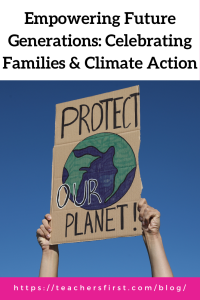The best gift we can give to our children is a greener future. We don’t need to give them anything special.
Bhuwan Thapaliya
The future of our planet rests in the hands of the next generation. As educators, we have a unique opportunity to shape young minds and inspire them to become champions of environmental change. On May 15th, we celebrate the 30th anniversary of the International Day of Families, and this year’s theme, “Families & Climate Change: International Year of the Family + 30,” serves as a powerful reminder that the journey towards a greener future begins at home.
Families are the foundation upon which values, habits, and beliefs are built. By involving families in climate change education, we can create a ripple effect that extends far beyond the classroom walls. Imagine a world where children not only learn about sustainability but also witness and participate in eco-friendly practices within their own households. This hands-on experience can instill a deep sense of responsibility and motivation to protect our planet.
As Bhuwan Thapaliya eloquently stated, “The best gift we can give to our children is a greener future.” We don’t need extravagant presents or grand gestures; instead, let’s empower our students with the knowledge and tools to tackle climate change, ensuring a healthier, more sustainable world for generations to come.
To kickstart this celebration, it’s important to introduce some climate change basics for students. This TeachersFirst curated collection of resources about climate change can help teachers and students learn about the short and long term impact of climate change. If you need some help creating a lesson, our resident teacher librarian has you covered in her article: There is No Planet B. The NASA Climate Kids website (reviewed here) is also a great resource for elementary educators.
Once they are armed with the basics, you can empower your students to engage meaningfully with the theme of climate change within their families and communities. Below are a few ideas on how you can spark this conversation in your classroom and begin students on the journey of becoming climate advocates.
Bringing in Expert Voices
First, consider bringing in experts or community leaders for virtual talks or classroom visits. These experts can provide valuable insights, share success stories of climate action, and inspire students to take meaningful steps towards a sustainable future. STEM Learning has a Climate Ambassador Program that you can use to get climate experts from around the world into your classroom.
Educational Resources Creation
Encourage students to create informative materials to raise awareness about climate change. They can design visually appealing infographics using tools like Canva (reviewed here) or Piktochart (reviewed here). Alternatively, they could build a project website using Canva or Google Sites (reviewed here).
If your schedule permits, have students present their infographic designs or website projects to the class. You could even invite parents or community members to attend these presentations. This fosters peer learning while allowing students to practice public speaking and advocacy skills.
To enable broader access to their climate change awareness efforts, students can record videos explaining their infographics or walking through their websites. These videos could be created and shared on Flip (reviewed here) or created in Adobe’s Animate from audio (reviewed here) and uploaded to Padlet (reviewed here).
Involving Families in Climate Action
- Encourage students to share their climate change projects or resources with their families and discuss the importance of sustainable practices at home.
- Organize a family night where students can present their work, and families can learn about simple eco-friendly habits to adopt.
- Share a list of community cleanups, tree planting drives, or other local environmental initiatives that families can participate in together.
- Provide resources for families to calculate their carbon footprint and explore ways to reduce it through changes in transportation, energy consumption, or food choices.
The Importance of Year-Round Climate Advocacy
While commemorating the International Day of Families is important, the essence of climate change is about consistent efforts. It’s crucial to instill in students the understanding that their actions and initiatives for a sustainable future are not limited to specific occasions but are ongoing commitments. Consistent engagement in climate advocacy throughout the year cultivates a culture of environmental stewardship, resilience, and innovation.
As we celebrate the International Day of Families, I encourage all educators to integrate climate change education into the classroom culture and curriculum. Together, we can inspire the next generation to create positive change for our planet. Share your ideas in the comments below.



This is a great idea! I end my Global 2 class discussing World Organizations and how they try to tackle issues of Climate Change, Global Warming, Deforestation, and Desertification…my goal is to really try and convince our future generations of the importance of this issue. I really try to scare that about it haha. But what they also need is to know how to try and approach this issue to implement real change. That is where I need access to more resources to do so, and you have some great resources here! Thank you!
Teaching climate advocacy is incredibly important. A lot of time is spent developing student interest in social issues. What I discuss with my senior class is that none of the other social issues matter if we do not live on a healthy enough Earth to argue on! These ideas are so strong, and I will be incorporating them into my instruction. Thanks!